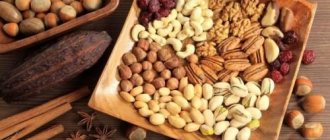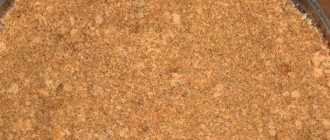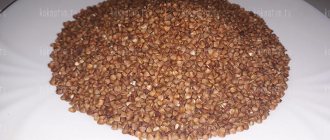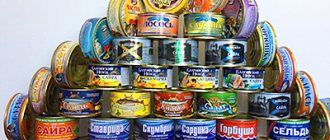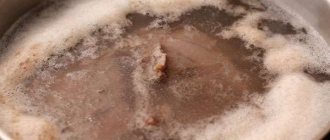Storage methods
Next, let's talk about how to store shelled walnuts at home. The shelf life of peeled nuts directly depends on the storage method. If you want to preserve the kernels for daily use for a month, you can place them in a glass jar, tightly seal them with a plastic lid, and place them on a kitchen cabinet shelf. How long can nuts be stored in this form? This method is appropriate for storing a small amount of fruit that will be used within 20-30 days.
Do not store kernels at room temperature for a long time. Regardless of whether you bought peeled fruits at the market or prepared them yourself, you won’t be able to store them for a year in your apartment. After lying in a warm place for a long time, the nuts acquire a bitter taste, dry out and lose their appetizing appearance. They will not only become tasteless, but can also be harmful to health.
To eat healthy nuts all year round, it is best to store them in the refrigerator, where they will remain fresh for 6 months. For containers, be sure to use sealed containers made of glass, ceramics or food-grade plastic. For convenience, some housewives immediately chop the product in order to get ready-to-use nut crumbs out of the refrigerator. If you are confident in the quality of the nuts, they can be stored in the refrigerator in any form.
It is convenient to store walnuts in the freezer in airtight bags with a resealable zipper.
Alternatively, you can store the fruits in the cellar or on the balcony, but in this case you need to monitor the humidity level in the room. If it exceeds 70%, the nuts will soon become moldy.
Another proven storage method is freezing. Place the peeled kernels in sealed bags and place in the freezer. Food foil or film is also suitable for packaging. It is not recommended to store kernels near strong-smelling foods to prevent the absorption of foreign odors. The shelf life of frozen walnuts is up to 12 months.
Green unripe fruits are not suitable for long-term storage
To learn all the intricacies of storing walnuts, it is better to read the reviews of gardeners involved in growing and selling them. The main condition for long-term storage is a high-quality starting product. If you have selected fresh fruits, use our tips to enjoy the valuable kernels longer.
Rules for choosing good nuts
Hazelnuts
You need to be careful when choosing this product in order to get the full range of useful substances. If the purchased product initially has some defects, chips and traces of mold development, proper storage will play a small role. Pay attention to several criteria for normal nuts:
- there should be no chips;
- nuts should not be too dried out or broken;
- ensure the uniformity of the shade: there should be no stains or traces of mold;
- shells must be smooth and uniform;
- when shaking the nut, no loud knocking should be heard: this happens with half-empty fruits;
- the smell should be pleasant;
- There should be no unevenness or wrinkles.
To purchase the most natural nuts possible, it is important to monitor the country in which they are purchased. For example, cashews are often imported from the Middle East, walnuts from France, pistachios from Iran, and peanuts are very popular in China.
How to properly collect and peel nuts
With fruits that fall to the ground on their own, there can be no problems in collecting them - you just take them and collect them with your hands into a suitable container.
But if you have several trees and the harvest is quite serious, then there is a special tool - a roll for collecting walnuts.
You can see how this tool works (and it can be used to collect nuts on both flat and uneven surfaces) in the following videos.
Video: how to quickly collect fallen walnuts on any surface
The main difficulties, as a rule, arise with fruits that are already clearly ripe, but still hanging on the tree. If you have a small tree, you can remove the nuts by hand, the same goes for harvesting from the lower branches of large trees.
But removing nuts from the top branches of tall trees is no longer such a simple task, which can be solved in 2 ways:
- shake the tree itself or its individual branches with your hands, for example, this can be done by climbing a ladder.
- again, you can use special tools for removing on a long stick (pole), for example, with a hook at the end, or some other design.
How to peel the green peel (pericarp) from fruits
It’s good when the nut fruit falls out of the pericarp while still on the tree. It’s also good when it is released when it falls to the ground, or the skin is detached already on the ground. This happens in most cases.
But it often happens that the fruits have to be removed from the pericarp yourself, which can be quite difficult (you will have to work tediously and monotonously with a knife). This must be done, and as soon as possible, if you want to get high-quality light nut kernels. This necessity is due to the fact that the green peel retains heat inside the nut, which means that the pericarp itself gradually begins to rot, and the shell and kernel darken, that is, the nut begins to lose its taste.
In general, those who grow walnuts for sale, that is, in fairly large volumes, as a rule, use various kinds of special machines for quick cleaning, for example, as in the next video.
Video: industrial method of peeling nuts from green peel
After you have peeled the fruits from the amniotic peel, they should be washed in water and then, if desired, bleached, for example, in a salt solution (5 kg of salt per 10 liters of water). After the bleaching procedure, which lasts 1-2 minutes, the fruits should be thoroughly rinsed in clean water.
Video: how to properly collect and prepare (dry) nuts for storage
How to store unshelled nuts
Storing nuts is actually not difficult. Their main enemies are dampness, high temperature and light. When exposed to moisture, the fruits become moldy and unfit for consumption, and due to high temperatures, they dry out. Since the kernels contain a large amount of oils, under the influence of heat and sun they begin to taste bitter, and in the shell they become oily in appearance.
Do not try to get rid of mold, even if the nuts are in an unshelled state! There is no way to remove toxins that have managed to penetrate the core! Eating such nuts is dangerous to your health!
Any nuts are stored in a dry, dark and cool place. Maximum temperature 20 °C. The cooler it is, the longer their freshness will remain.
If you bought fruits at the market, be sure to ask whether they were dried. If you collected them with your own hands, be sure to remove the outer shell (not to be confused with the shell!).
If the kernels were lying on the ground, then, of course, they need to be washed. It is convenient to do this in a large bowl or bath if there are a lot of nuts. By the way, this way you can determine which nut is good and which is bad. Fruits floating on the surface of the water can be safely thrown away - they are empty inside.
After the kernels have been washed, they are distributed on a flat surface in one layer. Before doing this, it is advisable to place the wet fruits on a sieve to drain excess water. When they are completely dry, they are poured into fabric bags and stored in a cool, dark place.
In order to extend shelf life, nut kernels are fried. Thanks to this, they become tastier, but, unfortunately, less healthy. You can also dry the fruits in a low-heat oven (50–100 °C) for 10 minutes. This way they will not lose their beneficial properties, and excess moisture will evaporate.
If the environment is too humid, mold may appear on the nuts.
The shelf life of raw, unpeeled nuts will depend on the type. Below, using the table as an example, we will consider storage periods and optimal conditions specifically for each type.
Table: storage conditions for inshell nuts
| Type of nut | Storage options | |
| Period | Temperature, °C | |
| Walnut, Manchurian, black, pecan | 1 year | 10–14 |
| Hazelnuts, hazel | 3–4 years | 3–12 |
| Cedar | up to 6 months | before 18 |
| Brazilian | 2 years | up to 20 |
| Pistachios | 6–12 months | 4–20 |
| Peanut | 12 months | before 18 |
| Almond | more than 1 year | before 18 |
| Chufa | 2–3 | up to 20 |
| Chestnut | 1–3 months | 10–15 |
| Muscat | up to 9 years | 20 |
| Coconut | 1–3 months | 10–15 |
Coconut, unlike other nuts, is not stored at a humidity less than 50%. The fact is that there is liquid inside the coconut. The lower the humidity, the faster it dries out, and the juiciness and taste of the pulp are lost.
Chestnuts spoil quickly even in the refrigerator. At room temperature, the fruits dry out and lose their quality, and in the refrigerator they become moldy. It is best to store chestnuts in the basement, burying them in the sand. This way they can be stored for up to 6 months.
Nuts are stored not only in the refrigerator, but also in the freezer, which extends their shelf life many times over. Most often, peeled kernels are used, which deteriorate faster and take up less space.
Features of the preparatory stage
Before storage, it is advisable to sort fresh nuts and dry them properly. The ideal drying method is to spread it on a large sieve in a continuous layer (not in bulk) and expose it to the sun. Warm, dry weather is suitable for drying nuts. It is important that they are outdoors, preferably in the wind. The first days when the shell dries are most important for successful drying.
In wooden boxes, nuts dry for up to 6 weeks. Once drying is complete, you can place them in mesh bags and hang them in a dry attic. The second option is to place in paper bags and store in a dark, dry, cool place in the house (for example, in a pantry).
Important! A good way to dry nuts is on a heating device, in an oven, at a temperature of 40-50°C. They should be poured in one layer. Properly dried nuts in the shell are stored until the next season, i.e. suitable for use throughout the year.
Peeled nuts (kernels) can also be stored for a long time. When filled with honey, they are suitable for consumption for up to 4 years. The advantage of this storage method is that the nuts do not take up much space. In addition, during cleaning you will sort out all damaged, spoiled kernels. This will help prevent damage to the healthy product. There are several ways to store nuts. They depend on the specific species.
Tara
When storing nuts, it is important to prevent them from absorbing odors from other foods. To do this, pour them into 2 bags, between which place a piece of absorbent sponge. You can also use zip-lock bags or pouches with the ability to remove air with a vacuum pump.
Another container for storing dried nuts is breathable (eg jute or mesh) bags. The basic requirement is to place them in a dry, but not too cold place. Don't leave them in boxes on the ground. “Unwanted consumers” in the form of rodents may begin to feast on your useful harvest.
Why do they do this?
It is believed that soaking “awakens” the nut kernels. The fact is that in dry form they are in a state of hibernation, while the pulp contains inhibitor substances designed to protect the seed from adverse natural factors. Having awakened, the nut gets rid of inhibitors - and, as a result, is better absorbed.
The theory is questionable: most of the mass of the kernel is endosperm, which, without the help of the embryo, responds little to external influences, and is certainly not capable of starting to grow. However, adherents of a raw food diet adhere to such views.
There is no doubt about another effect of soaking - swelling and softening of the pulp. Having collected water, the nut kernel becomes softer and more delicate in taste. This is useful for those who have problems with the gastrointestinal mucosa: nut grains, even chewed, can injure the esophagus and stomach - and when soaked, the kernels can be eaten even in the initial stages of gastric erosion.
In addition, soaking removes tannins from the nut, which gives it a characteristic bitter taste, especially noticeable in young, under-dried seeds. As a result, nut pulp is better absorbed: according to some researchers, magnesium absorption can ultimately increase by one and a half times.
Finally, soaking can also be a hygienic measure
This is especially important when buying nuts in shelled form: during storage, whole and crushed kernels accumulate dust, mold spores, harmful bacteria can be deposited on them, and if they were handled with unwashed hands, then eggs of intestinal parasites. Thorough washing and soaking will remove dirt and pests from the nuts.
Storage rules depending on the type of nuts
Each type of kernel requires its own specific conditions. And this should be taken into account. Especially if the task is to preserve the unique qualities of such fruits.
Walnuts
They are best stored at above-zero temperatures of 5-13 degrees and in shells. If the kernels are placed in a fabric bag, then in this state they can lie perfectly for up to six months. But in a glass jar their shelf life is extended.
Peeled walnuts can be frozen. This will not affect its taste. But if you want to put whole fruits in the refrigerator, then each nut should be wrapped in foil. They will remain in this state for several months.
Cedar
Pine nuts have a short shelf life. Unpeeled kernels can last up to 6 months. If the fruits have been exposed to heat or excessive light, then after three months their taste will begin to deteriorate. You should not store them in the refrigerator, they do not like low temperatures.
It is recommended to store peeled pine nuts in a vacuum bag. And after opening they should be eaten.
Macadamia
Macadamia nuts are perfectly preserved in the shell. When the temperature is maintained between 0 and 10 degrees Celsius, the kernels will last up to 2 years. Without the shell, macadamia nuts will remain fresh for up to a year if the fruit is vacuum-sealed.
Brazilian nut
Those Brazil nuts that are fully ripened will last a long time. Once purified, the kernels can last up to two years. Ideal conditions in this case are temperatures from 3 to 10 degrees Celsius.
But in the refrigerator, Brazil nuts will remain fresh for 4 weeks. If it is placed in a plastic container that is kept in a warm room, such a fruit will last for one year. In the freezer, such nuts remain fresh only for 3 months.
How and where you can store garlic in your apartment and house
Cashew
In a cool room they can last up to 5 weeks. They can also be frozen by first placing them in a resealable bag or wrapping them in cling film. Cashews can last up to 6 months in the freezer.
Outside the refrigerator, these kernels can be stored in containers made of glass, clay, or high-quality plastic
It is important that the container is equipped with a lid that closes tightly
Almond
Almonds are stored where it is dark and dry. As a suitable container, you need to choose a glass jar. And such fruits can remain in the freezer for 3 years. If you put it in the refrigerator, they will stay fresh for up to 12 months. At room temperature this fruit lasts for 6 months.
Hazelnut
Hazelnuts retain their properties better when in the shell and at temperatures from 3 to 15 degrees Celsius. They can stay like this for a year. In cooler conditions, when temperatures range from 0 to 3 degrees, hazelnuts can last up to 4 years.
Pistachios
These nuts can last 2 years in the shell and in a cool place. In normal room conditions they last for 1 year, but without shells they last only 3 months. They will keep for a long time in the freezer.
Peanut
You can store peanuts in a cool, dark place. Then it will last up to a year. Under warm conditions, the shelf life is reduced by several months. If the goal is to prolong it, then the peanuts can be put on the refrigerator shelf.
Chestnut and pecan
Chestnut will feel great in the sand. The fruits will remain in this state for several months. In the refrigerator they can stay fresh for 2 months, and in the freezer this period increases to 6 months.
Pecans should be kept in their shell. The peeled kernels should be placed in the freezer, packed in sealable containers. Then they will lie for 6 months.
Nutmeg
Store whole nutmeg in an airtight container. Then he will be able to lie there for 2 years. This fruit should not be frozen or placed near heating appliances.
Coconut
Coconut is essentially a plant that also requires certain conditions. It can easily lie for 3 months at a temperature of 4 to 7 degrees Celsius. Subsequently, its pulp will become hard and the milk will begin to evaporate.
Coconut does not tolerate sudden temperature changes. And if it is opened, it will be edible for three days. But coconut flakes can retain their structure for 12 months.
What to store in
Unpeeled kernels can be kept in a box made of wood or cardboard. But the peeled ones should be placed in containers made of clay or glass. Clay jars with a snap-on lid are a good option. Unpeeled fruits can be placed in bags. It is better to refuse plastic bags. In them, the kernels begin to rot, losing their taste properties.
Glass containers
If you choose a glass or plastic container for storage, it must be clean and dry. The lid should snap or screw tightly. The condition of complete sealing must be achieved.
Plastic containers
You should not choose plastic bags for storage. Despite their good sealing, they allow odors to pass through, which negatively affect the taste of the fruit.
Box, box
Wooden boxes and paper boxes are suitable for storing unpeeled kernels when large quantities are involved. It is better to place them in places where the recommended humidity level is maintained. Before placing the fruit in the selected container, it should be checked for absolute dryness.
Marking according to GOST
The product in shell is transported in fabric or paper bags. The bags or labels are marked with the following information:
- names and addresses of the sending organization;
- product names;
- commercial grade;
- harvest year;
- gross and net weights;
- packaging dates;
- quality certificate numbers.
Nut kernels are placed in airtight packaging, vacuum packaging or in inert gas packaging.
The following is applied to the packaging, label or sticker:
- Product name.
- Type of product (“halves”, “quarters”, “large pieces”, “large pieces and halves”).
- Manufacturer's name and location.
- Manufacturer's trademark (if available).
- Net weight.
- Pomological variety. Characterized by ripening time, growing location, etc.
- Commercial grade. Indicates quality, determined by numbers - 1st grade, 2, 3.
- Year of collection and date of packaging.
- Storage conditions and shelf life.
- Information on the use of genetically modified organisms.
- Information about confirmation of conformity.
Instead of the name and location of the manufacturer, indicate the full name of the individual entrepreneur-manufacturer, the person authorized by the manufacturer, the name and location of the importing organization or the full name of the individual entrepreneur-importer.
Basic principles of storage
In order for nuts to remain tasty and of high quality longer, you need to remember the following factors that affect their shelf life:
- temperature regime. The higher the temperature at the storage location, the shorter the shelf life of the fruit;
- ripeness. Unripe kernels are not suitable for saving;
- presence of additives. Peeled nuts must be carefully sorted before storage. Among the kernels there should be no pieces of shell or bridges, as well as low-quality fruits. You should not save nuts by mixing them with sugar, honey or other ingredients - this will shorten their shelf life significantly;
- treatment. Nuts should not be cooked before storage. People often confuse drying and frying and make an irreparable mistake. You can dry the peeled fruits a little, but it is best to do this immediately before using them for food. Only unshelled nuts can be roasted;
- storage container. Avoid plastic bags as containers except for freezer storage;
- storage. Only if stored in the freezer and maintained at a constant temperature can you count on a long shelf life - about a year. Thawed fruits cannot be re-frozen.
If you keep these factors in mind, it will be much easier to preserve nuts not only until winter or spring, but also until the next harvest.
Useful tips and possible problems
Peeled nuts are the most susceptible to spoilage. It is not advisable to store them in plastic bags. They sweat in them. Coconut should not be placed next to apples or bananas, as it will rot. But cashews are not allowed to be kept near an electric or gas stove, or near a battery. Otherwise, the fruits will lose their natural taste and begin to secrete excess oil.
Nuts are a valuable and nutritious product. But you need to be able to store them correctly. Knowing the ideal conditions for each type of kernel, they will lie for a long time, remaining fresh, tasty and healthy.
How to store pine nuts at home: rules and principles
Storing nuts depends on the method of processing. When organizing these conditions, you should remember several varieties of this product:
- peeled, unfried;
- peeled fried;
- nuts in cones;
- fruits in shell.
How to store them at home depends on the variety.
Preparing nuts for storage
Before organizing preparations for autumn and winter, nuts need to be well prepared. First of all, the product needs to be dried like this:
- Spread the nuts on any convenient surface in one layer.
- Leave in a warm place for a week.
- Stir occasionally.
Drying nuts can be done in special dryers
It is important to ensure that they do not dry out. If the product is wet, it will quickly deteriorate and mold will appear.
Storing unshelled raw
Shelled pine nuts
They are stored in two ways:
- In a refrigerator.
- In the freezer.
Refrigerator storage instructions:
- place the nuts in dry glass jars;
- close the lids so as to prevent the absorption of excess odors, but also to prevent the product from suffocating;
- put in the refrigerator.
Cedar fruits are stored in the refrigerator for about 3 months.
Freezer storage:
- Divide the product into freezer bags;
- seal tightly;
- put in the freezer.
This way the nuts are stored for about six months.
In cones
Nuts and pine cones
Such nuts do not last long and at the same time lose both their taste and their benefits. Most often, cones are used as a decorative element. However, if such storage is necessary, it is necessary:
- place the cones and nuts in canvas bags;
- put in a cool, dark place with good ventilation;
- if necessary, hang the bags from the ceiling, excluding access by rodents.
It is important to remember that in the room where the buds will be stored, the humidity should be low, otherwise the product will become moldy
In a shell
Nuts in shell
There are three storage options:
- In canvas bags (nuts are stored in the same way as cones).
- In special polyethylene bags with an air membrane. They are stored for a maximum of 3 months.
- In a refrigerator.
The procedure is the same as for raw peeled ones.
Basic nuances associated with storing nuts
- nuts harvested in September are stored much longer, since at this time the cones are optimally mature;
- to remove nuts from the cones, you need to knock on it and then shake it;
- Only thoroughly dried fruits should be stored and only dry containers should be used for storage;
- peeled nuts in syrup, sugar and other additional ingredients cannot be stored for a long time; it is advisable to consume them immediately after purchase;
- pine nuts contain a lot of oil, so you shouldn’t buy them for future use;
- for safety, it is better to use containers with lids or sterilized jars;
- store the product not only in the freezer or refrigerator, but also in any other cool, dark place;
- for freezing, you can use both containers or jars, and plastic bags or foil;
- peeled fruits cannot be stored open;
- during storage, you need to check the product not only for taste and smell, but also for plaque, mold, and the presence of insects;
- if the nuts are bitter, and the surface is covered with a coating, then you cannot eat them;
- It is better to store nuts in shells, since peeled ones do not retain their benefits and taste for long.
How long are they stored?
If nuts are purchased in packaging, they should be stored in the dark until opened. The manufacturer always indicates the duration of such storage. However, once the packaging is opened, they cannot be stored for a long time. Peeled - for several weeks, in shell - up to 2 months. It is worth remembering that you cannot store nuts in the packaging itself; it is better to transfer them to a suitable container. The optimal shelf life for nuts purchased without packaging is no longer than six months if the nuts are in shell, and a maximum of 90 days if the nuts are unshelled. Staying in the freezer or refrigerator provides the same time limits.
You only need to take nuts that are slightly damp to the touch and firm. They should have a pleasant smell, not a pungent and musty one. If the nuts are fresh, their kernels will be light. Dirty yellow or greenish kernels will be rancid. If the nuts are peeled, they should be packaged in opaque containers, since under the influence of light this product quickly deteriorates and becomes bitter.
In shell or without it
Walnuts can be stored in shells or shelled. By ensuring sufficient shell density, you can store the product for a long time. However, this requires more time and effort. To get kernels, it is not necessary to chop nuts in the shell; it is enough to purchase already peeled kernels.
There are two main storage methods:
- In a shell. It is not difficult to provide optimal conditions for storing the product in the shell. The room in which storage is intended must have a humidity of no more than 60%, at a temperature no higher than 20 degrees Celsius. It is recommended to select dishes from metal or glass. Shelf life: no more than 6 months. When stored in canvas bags or wooden containers, the period is reduced to several months.
- No shell. This method is considered more difficult. The best option is sealed packaging placed in the refrigerator. Purchase special storage bags or plastic containers for this purpose. Freezing is possible for no more than two months. The loss of product value is minimal.
How to store peeled fruits
The storage location should be cool, dark and well ventilated. Kernels without shells are not stored open, as they quickly absorb foreign odors and begin to deteriorate. They are poured into glass or metal containers with a lid. It is highly undesirable to use plastic bags - the nuts will rot there. But if you are going to put them in the freezer, then there will be no problems.
Nuts are best stored in glass jars or containers.
The difficulty of storing shelled nuts also lies in the fact that they often harbor insect larvae, such as food moths. By purchasing them, you risk purchasing a contaminated product. If you are confident in the quality of the fruits, feel free to place them in an airtight container. If not, first bake in the oven at 200 °C for several minutes or in a dry frying pan with a thick bottom.
Table: shelf life of unshelled nuts
| Type of nut | Storage | ||
| Cool, dark place | Fridge | Freezer | |
| Walnut, Manchurian, black, pecan | 3–4 weeks | 6 months | more than a year |
| Hazelnuts, hazel | 2–4 weeks | 3 months | 6 months |
| Cashew | 1 month | 2–3 months | more than 6 months |
| Brazilian | 1 year | 1–12 months* | 2 years |
| Pistachios | 3 months | 9 months | 12 months |
| Cedar | 1 week | 2–3 weeks | 6–8 months |
| Peanut | 6–9 months | 4–6 months | 9 months |
| Almond | 3 months | 12 months | more than a year |
| Coconut | — | 2 days | — |
The safety of Brazil nuts depends on the packaging. If stored in a plastic bag on one of the refrigerator shelves, the shelf life will be a maximum of 1 month. They can be stored in an airtight container for over a year. When crushed, nuts can be stored for no more than 3 weeks.
A coconut without a shell quickly becomes tasteless and limp. It consists of 46% water, so it can ferment after two days. Coconut water can be stored in the refrigerator in a tightly closed glass jar for no more than a week, in the freezer for up to 3 months. If the pulp is crushed and dried, it can be stored for a year.
Peeled pistachios begin to lose their taste after 3 months, and it makes no difference where they are stored: in a cabinet, refrigerator or freezer.
As for chestnuts, they are rarely stored in a raw, peeled state. The fact is that raw chestnuts are quite difficult to peel. This will require a lot of effort and patience. After cleaning, chestnuts are placed in a plastic zip bag or food storage container and placed in the refrigerator for several months, or better yet, in the freezer.
Another problem with storing shelled nuts is that you never know for sure when they were shelled. There is only one way out: rely on your own instincts and sense of smell.
As for salty and sweet nuts, they are eaten immediately after opening the package.
Nuts that don't require peeling
Not all types of nuts require shelling. Chufa or ground almonds, as they are also called, are not peeled at all. In fact, this is not a nut, but tubers of a herbaceous plant - edible cyperus. After drying, the fruits wrinkle greatly; it is almost impossible to peel such nuts. Before storage, chufa must be washed and dried, after which it is stored in fabric bags in the basement or indoors.
This type of cashew is sold only in peeled form. The fact is that it is covered with a very poisonous shell containing the poison cardol. It is not recommended to peel nuts by hand, as this substance can cause burns if it comes into contact with the skin. Therefore, cashew nuts are cleaned using special equipment, and they go on sale without the shell.
Chufa is probably the only nut that does not require peeling
How to store crushed and grated nuts
It is not recommended to store crushed nuts for a long time. Many housewives prefer to prepare large quantities of peeled and crushed kernels to use in baking and cooking. But in this form they quickly deteriorate and consuming such a product can be harmful to health. Chopped walnuts have a shelf life of 1-3 weeks, unlike shelled butterfly kernels. Almond petals begin to lose their quality after just a few days. Grated kernels are not stored at all. As an exception, only coconut or nutmeg, which can be stored for up to a year in a closed bag or jar.
Chestnuts: cleaning and storage
Storing chestnuts in a bag
After heat treatment, chestnuts should be peeled with a knife, unlike their “brothers”. Preparing chestnuts is impossible without proper cleaning:
- Place the dried pan on the stove.
- Make an X-shaped cut on each chestnut.
- Place the fruits in a frying pan and fry without oil for ten minutes.
- After opening the chestnuts, remove them from the stove and peel the kernels. To do this, simply squeeze the chestnut with your hand and wait until the peel bursts.
You can prepare chestnuts in the oven and microwave. To do this, preheat the oven to 200 degrees and place a baking sheet with chestnuts in it. After opening the peel, the chestnuts are pulled out, cooled and peeled by hand.
To prepare chestnuts in the microwave, prepare a glass container filled with water and place the chestnuts in it. Turn on classic mode and bake chestnuts for 20-30 minutes. During this time, the chestnuts will burst and be easily removed from the peel. It is important to note that in each case of processing chestnuts, cuts should be made on the surface of the kernels: otherwise they may burst and stain the oven or microwave.
Once peeled, chestnuts will only last a few days in the refrigerator. The lifespan of chestnuts can be increased by avoiding cleaning; they also prefer ventilated and dry places.

